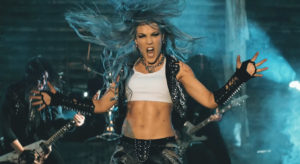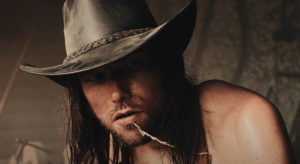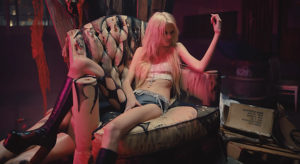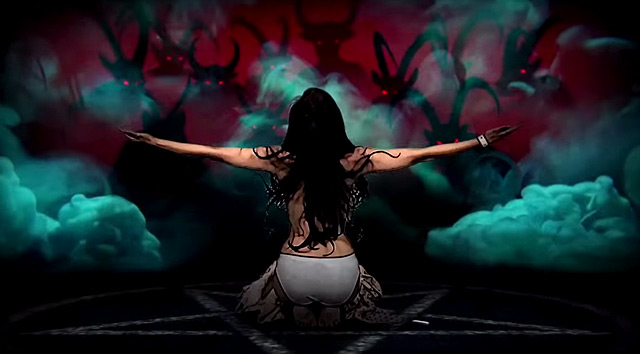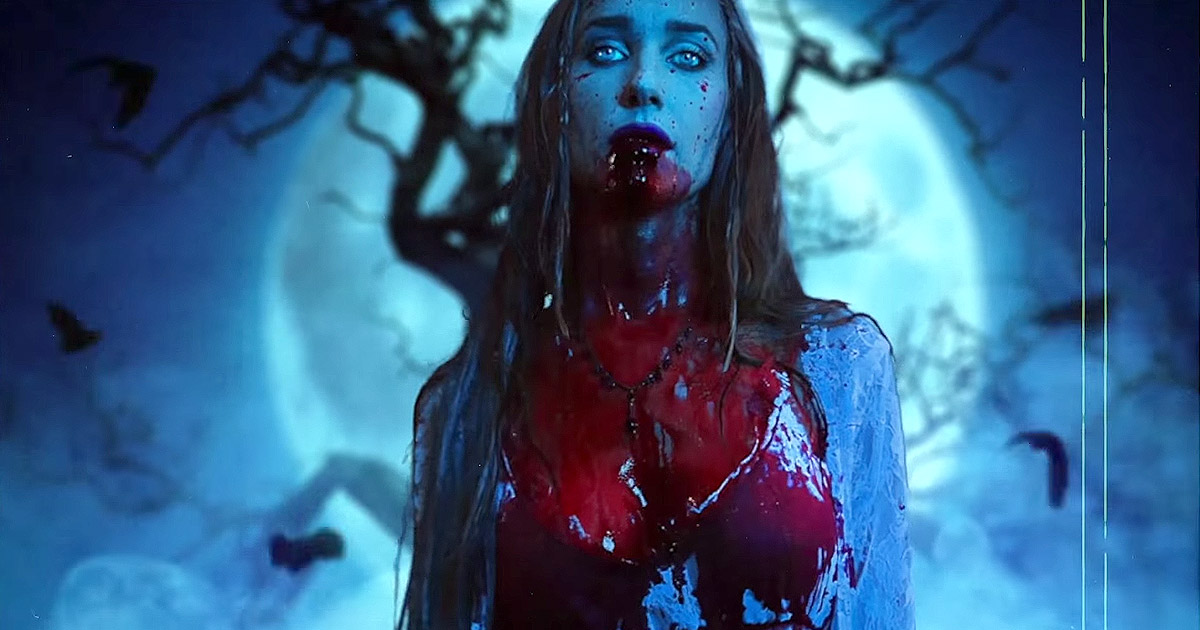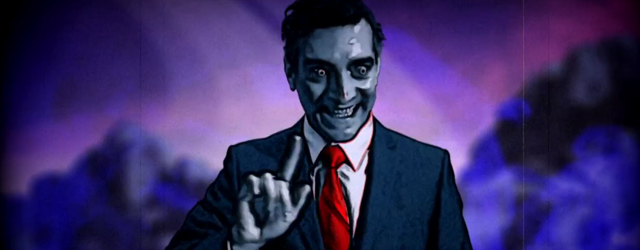Read English Version
Eres (fotógrafo y también) director de videoclips. Cuéntanos un poco más acerca de cómo te metiste en el mundillo…
Empecé como fotógrafo en Nueva York, fotografiando mucha música, moda y anuncios, todo con un estilo y unos efectos bastante cañeros. Pero cada vez me amargaba más haciendo ese trabajo, así que cuando conseguí juntar suficiente pasta grabé mi primer corto, ‘The Listening Dead‘. El primer día de grabación me di cuenta de que eso era lo quería hacer, y cuando el corto recibió el respaldo de un montón de festivales de cine de todo el mundo, sentí que había recibido una llamada.
Con todo, entrar en el mundo de los videoclips no fue fácil. Tuve que convencer a los sellos de que podían confiar en mí y que podía hacer lo que me pedían (al principio). Por eso mis primeros vídeos tienen un estilo más ‘estándar’. Los sellos tenían más pasta entonces, y como director novato siempre tenía a alguien vigilando. Rick Ernst de Roadrunner Records fue el primero en delegar en mi toda la responsabilidad del apartado creativo en un video de Opeth, y ahí es donde comencé a crear mi propio estilo visual.

«Rick Ernst de Roadrunner Records fue el primero en delegar en mi toda la responsabilidad del apartado creativo en un video de Opeth, y ahí es donde comencé a crear mi propio estilo visual»
¿Cómo te gusta trabajar a la hora de dirigir a los músicos?, ¿cuáles serían los pasos a seguir para definir la historia y el aspecto en general del conjunto?
Normalmente ya no aparecen los músicos en mis videos. De hecho, de los 18 videos que he grabado, la banda solo aparece en 8 de ellos (y uno de ellos nunca se publicó), y todos son anteriores a 2011. Huntress es el único grupo que aparece en los videos que he grabado en los cinco últimos años, y es porque Jill Janus es un portento y le encanta actuar. No dirijo mucho a los grupos, porque prefiero que se expresen libremente, y no sometidos a un guión. Quiero que se sienta y se vea exactamente como en sus shows. En el extraño caso de que se requiera su actuación, dirijo a los músicos como a cualquier actor: atendiendo sus particularidades y con respeto.
Hay muchos elementos que determinan cómo queda el guión final. Cuando me encargan un clip, normalmente el grupo me dice cuáles de mis videos le gustan más. Con eso en mente comienzo a poner ideas en una lista, que normalmente tiene entre 7 y 12 folios. Luego separo las ideas que más me gustan e intento trabajarlas conjuntamente para crear una historia que amplifique de algún modo la canción. Antes empleaba mucho tiempo en buscar referencias e ilustraciones para añadir al resultado final, pero ahora que ya tengo un puñado de videos a mis espaldas, solo lo hago por petición expresa. Prefiero que mis ideas no vengan de un artwork que ya existe pero que no viene de mi. Cuando va quedando ya el producto final (normalmente 2-3 folios), lo someto a la aprobación de la banda.
¿Sueles trabajar sobre la idea del grupo, o prefieres aportar tu propia historia según te inspira la banda y el tema que hayan elegido?
No, normalmente no trabajo sobre sugerencias de la banda. Prefiero que me digan cuáles de mis trabajos les gustan, lo que el tema significa para ellos y que me dejen darle me propia interpretación cinemática. Tengo suerte, porque creo que he llegado a un punto en el que hay respeto mutuo entre los artistas con los que trabajo y yo. No grabo demasiados videos al año, pero cuando lo hago es con una banda a la que respeto y que me respeta a mi.
¿Dirías que los músicos lo podrían tener un poco más “fácil” de cara a interpretar un papel por el hecho de estar acostumbrados a actuar sobre el escenario?
No. Creo que actuar y tocar en directo son cosas que tienen similitudes superficiales, pero son disciplinas muy distintas. Normalmente evito dar a los músicos papeles relevantes por ese motivo.
¿Cuál ha sido la situación más absurda o demencial con la que te has encontrado?
Hice un video de bajo presupuesto para una banda, cuyo nombre omitiré, que estaba concebido para grabarse en una sola toma. Era un concepto arenoso, pero fue aprobado de inmediato por el grupo y su sello. Teníamos la localización por un tiempo limitado, íbamos muy apretados y teníamos que llevar a cabo una toma muy difícil y sincronizada en un plazo de 8 horas. Por desgracia, el cantante apareció borracho, y siguió bebiendo todo el tiempo que duró la grabación. No pudimos hacerle entender que se grababa todo de una vez, y estropeaba las tomas constantemente. Nos llevó 7 horas que le entrara en la mollera y al final pudimos sacar una toma decente. No volveré a trabajar con ellos. Esa experiencia me enseñó la valiosa lección de no dar demasiada responsabilidad a un cantante con el que nunca has trabajado antes. Y para rematar la faena, cuando el video estuvo terminado, el sello lo guardó en un cajón por considerar que era demasiado ‘controvertido’.
«Me duele decir esto, pero como director, pienso que hacer vídeos musicales es algo que cada vez tiene menos valor. Normalmente los vídeos se lanzan, llaman la atención durante una semana, y luego caen en el más absoluto olvido»
En el plano personal, ¿qué dirías que es lo más gratificante de tu trabajo?
Inspirar lo suficiente a alguien como para que se ponga en contacto conmigo. La mayor recompensa del trabajo es la gente que trae a tu vida.
¿Te ha sucedido alguna vez que un grupo se “llevase” parte de su actuación en vídeo para mostrar después en sus posteriores conciertos (indumentaria, maquillaje, atrezo…)?
No de mi trabajo en video, a pesar de que se ha puesto en discusión alguna vez. Sí que hice el aspecto visual del escenario en la gira de Nik Turner (Hawkwind) hace unos años como favor a mi amigo/socio, el productor Dan Simpson, y al batería Jason Willer.
¿Cuánto tiempo puede llevar, aproximadamente, realizar y rematar un videoclip en términos generales?
Los videos de animación entre 2 y 4 meses, normalmente, dependiendo del presupuesto. Los videos con actores tardan entre 1 y 2 meses.
Un proyecto del que te sientas particularmente orgulloso…
‘The duke’ de Monster magnet, tanto por el video como por la gente tan increíble que conocí. También estoy muy orgulloso del nuevo video de Metallica para ‘Spit out of the bone‘, que ha sido creado en circunstancias muy difíciles, pero con un gran grupo de artistas y mucho amor.
«Huntress es el único grupo que aparece en los videos que he grabado en los cinco últimos años, y es porque Jill Janus es un portento y le encanta actuar (…) Antes empleaba mucho tiempo en buscar referencias e ilustraciones para añadir al resultado final, pero ahora que ya tengo un puñado de videos a mis espaldas, solo lo hago por petición expresa»
Es cierto. Has dirigido recientemente uno de los videos que Metallica publicaron hace unas semanas para cada uno de los temas de su nuevo disco. ¿CÓmo surgió la posibilidad de hacerlo? ¿Qué cara se te queda cuando Metallica contacta contigo?
Recibí un correo directamente de Robert Trujillo, diciéndome lo mucho que le gustaba mi trabajo, y preguntándome si estaría interesado en hacer un video para ellos. Me puse como una moto. Crecí escuchando Metallica, así que fue todo un honor que supieran mi nombre.
¿Hiciste todo el trabajo tu solo o tienes algún equipo que te ayuda?
Todas las grabaciones se hacen por un equipo de artistas, y este caso no fue una excepción. Escribí, dirigí, produje (con Ian Mackay), edité e hice todos los FX visuales en postpruducción, con la ayuda de Adam Avilla, que hizo las escenas animadas del virus propagándose y consumiendo el mundo. Mi compañero de producción Ian Mackay grabó toda la animación en stop-motion del video y trabajó con nuestra nueva directora de arte, Amanda Graeff y la maquilladora de FX Sioux Sinclair para crear el muñeco del Dios Robot que se ve en el video. Tuvimos mucha más ayuda en la producción principal, y Metallica tuvieron el detalle de poner los créditos en la pestaña de ‘Mostrar más’ cuando subieron el video, así que se puede ver quiénes participaron en este magnífico trabajo.
¿Te dieron algunas ideas o instrucciones previas sobre el guión, o es todo el resultado de lo que a ti te inspira el tema?
No hubo instrucciones específicas. Me dijeron que a James le encanta mi video para ‘Fertile green’ de High on fire, y que Robert es muy fan de todo mi trabajo, especialmente ‘Annihilation affair’ de Torche, que tiene temas similares. Aparte de eso, me dieron total libertad. Y debo decir que nunca me habían tratado con tanto respeto como artista como lo ha hecho Robert. Fue realmente gratificante.
«Nunca he vetado un género musical, pero sí he vetado a grupos que pretendían imponerme su guión o grupos cuya música no me gusta»
Si no es top secret, ¿nos puedes contar con qué equipo trabajas?
No tengo un equipo favorito, porque tampoco soy un maniático del equipamiento y tiendo a usar lo mejor para los directos. Dicho eso, estoy muy contento con mi handycam Sony FDR-AX100.
¿Hay algún género musical que tengas vetado, o crees que podrías rendir exactamente al mismo nivel en cualquier otro estilo?
Nunca he vetado un género musical, pero sí he vetado a grupos que pretendían imponerme su guión o grupos cuya música no me gusta.
¿A qué grupo has soñado siempre con hacerle un video? y ¿qué vídeo mítico de todos los tiempos te gustaría haber dirigido?
No tengo una banda soñada a la que dirigir, y no pienso en los vídeos musicales de esa forma.
Para terminar, nos gustaría saber, en tu opinión qué aporta un video a la promoción de un grupo. Y, si alguien quiere saber cómo es grabar un video contigo, ¿dónde puede echar un ojo a tus trabajos anteriores y contactar contigo?
Me duele decir esto, pero como director, pienso que hacer vídeos musicales es algo que cada vez tiene menos valor. Normalmente los vídeos se lanzan, llaman la atención durante una semana, y luego caen en el más absoluto olvido. Cada vez menos publicaciones escritas y medios online hacen un ‘mejor vídeo musical del año’, que era algo que venía bastante bien para la promoción. Y los vídeos que yo he hecho eran de un presupuesto tan bajo que podías darte con un canto en los dientes si podías cubrir tus propios gastos mientras los haces. Es la principal razón por la que hago tan pocos, y soy tan selectivo con los que acepto. Algunos de nuestros vídeos favoritos, que incluso otras bandas mencionan como sus favoritos, ni siquiera han llegado al millón de visitas. Algunos no tienen más de 200k reproducciones, así que no sirven mucho de promoción. Su mayor valor es hacer que bandas como Disturbed o Metallica, con audiencias enormes, se acerquen a nosotros. Con los vídeos musicales, el propio trabajo debe ser la recompensa, porque el beneficio económico es nulo.
Los lectores pueden encontrar más sobre nuestro trabajo en www.diabolikfilms.com y seguirme en Facebook, Twitter e Instagram (@phil_mucci).
ENGLISH VERSION
You’re a filmmaker of music videos (and also photographer). Tell us something more about your first steps into the world of video clips.
I started out as a photographer in New York City, shooting lots of music, fashion, and advertising – all with a very special FX heavy style. But I became increasingly unhappy doing that type work, so when I finally had enough money, I made my first short film, The Listening Dead. I realized on the first day of shooting that filmmaking was what I really wanted to do, and when The Listening Dead received accolades from film festivals all over the world, I felt I had found my calling.
Getting into music videos wasn’t easy, though. I had to convince record labels that they could trust me to do what they wanted (at first). That’s why the early videos are more “standard” in style; the labels had more money then, and as a new director, I always had someone looking over my shoulder. Rick Ernst at Roadrunner Records was the first person to give me the creative reigns completely on the Opeth video, and that’s really where I started developing my own unique visual style.
How do you like to direct the artists?, what are the different steps to define the story and put all the elements together?
I rarely have the musical artists in my videos anymore. In fact, out of the 18 music videos I’ve done, the band has only appeared in 8 of them (and one of them never got released) – and most of those were shot before 2011. Huntress is the only band to appear in the videos I’ve done in the last 5 years, and that’s because lead singer Jill Janus is such a gorgeous powerhouse who loves to act. I don’t direct band performance very much because I want the band to express themselves, not have some interpretation imposed on them. I want it to look and feel the same as their shows. In the rare case that there is acting required, I direct them exactly as I direct any actor – with a great deal of specificity and respect.
There are many steps that go into the final music video treatment (script). When I’m asked to do a video, the band usually tells me what videos of mine they really liked. With that in mind, I start by brainstorming ideas in a list that’s usually 7 -12 pages long by the time I’m finished. Then I take my favorite ideas and work them together into a story that amplifies the song in some way. I used to spend a lot of time finding reference and illustrations to add to the final treatment, but now that I have a body of work behind me, I only do so by request. I’d rather not have my ideas hinge on some existing artwork that doesn’t come from me. When I have a very tight treatment – usually no more than 2-3 pages – I submit it to the band for approval.
Do you like to follow the band’s suggestions?, or you tell them how to act based on your own story and the group aesthetics / song inspiration?
No, I don’t generally like to follow the band’s suggestions. I’d much rather have them tell me what work of mine they like, what the song means to them, and then let me come up with my own cinematic interpretation. I’m very fortunate to have reached a point where there’s great mutual trust between the artists I work with and myself. I don’t shoot many videos a year, but when I do, it’s for a band I respect and who respects me back!
Would you say that being familiar with playing live on stage makes role playing “easier” for a musician?
Not really, no. I think acting and performing live music have superficial similarities, but the disciplines are very different. I generally avoid giving musicians any serious acting roles for that reason.
What would be the most absurd or crazy situation that you faced so far?
I shot a low budget music video (for a band I won’t mention) that was conceived to be shot entirely in one take. It was a gritty concept, but it was approved immediately by the band and label. Securing a location for a limited time, we were under the gun and had to pull off a very complicated, choreographed shoot within 8 hrs. Unfortunately, the lead singer showed up drunk, and kept drinking the entire time – completely unable to comprehend that we were shooting it all “in one” and constantly ruining takes. It took 7 hours just to get that to sink in, but we finally got a decent take and called it a night. But I will never work with them again, and it taught me a valuable lesson about not giving too much responsibility to a lead singer you’ve never worked with before. And to top it all off, when the video was finished, the label shelved it for being “too controversial”.
What is the most rewarding thing about your job?
Inspiring people enough that they actually reach out to me. The greatest reward for your work is the people it brings into your life.
Has it ever happened something like the band using your video aesthetics for their own live show (clothing, makeup, atrezzo)?
Not from my music video work, though it has been discussed several times. But I did stage visuals for Nik Turner ‘s (Hawkwind) tour a few years ago, as a favor to my friend/associate producer Dan Simpson and drummer Jason Willer.
How long does it usually take the whole process of making a regular videoclip?
The animated videos take 2-4 months usually, depending on budget, while the mostly live-action videos take between 1-2 months.
One project that makes you feel specially proud?
Monster Magnet “The Duke”, both for the video itself and the amazing people I met from doing it. I’m also very proud of our new Metallica “Spit Out The Bone” video, as it was created under extremely difficult circumstances, but with a great group of artists, and a lot of love.
That’s true. You have recently directed one of the videos Metallica released a few days ago for every song in their new album. How did the deal came up? How did you feel when Metallica contacted you?
I received a direct email from Robert Trujillo (bass player/Metallica) telling me how much he loved my stuff and asking if I’d be interested in a doing a video for them. Of course I was ecstatic! I grew up with Metallica, so it was an incredible honor that they even knew my name!
Did you do the whole work on your one or did you have some kind of a team helping you?
All filmmaking is done by a team of artists, and this project was no exception. I wrote, directed, produced (with Ian Mackay), edited, and did all the visual FX in post (green screen, multi-image compositions, etc), with help from Adam Avilla (Toxic Holocaust “Acid Fuzz”) who did the animated sequences of the AI virus spreading and consuming the world. My producing partner and leading man, Ian Mackay, shot all the stop-motion animation in the video, and worked with our new art director Amanda Graeff and special FX makeup artist Sioux Sinclair to come up with the amazing Robot God puppet you see in the video. But we had even more help on the main production, and Metallica was kind enough to include those credits under the “Show More” tab when they posted the video, so everyone can check out who did the amazing artwork – from miniatures and custom props, to wardrobe and makeup FX.
Did you any instructions or previous briefing about the script or is it the result of what the song/lyrics inspire you?
There were no specific instructions; I was told that James loved my High on Fire “Fertile Green” video, and that Robert himself was a huge fan of everything, especially Torche “Annihilation Affair”, which had very similar themes. Other than that, it was left up to me. And I have to say, I don’t think I’ve ever been treated with as much respect as an artist than I was by Robert – it was truly humbling!
What is your favorite gear (if not a secret)?
I don’t really have a favorite, as I’m not much of a gear-head, and I tend to just use the best gear for the gig. That said, I’m very happy with my SONY FDR-AX100 4K camera.
Is there any music genre that you have vetoed, or do you think that you can perform at the same level on any case?
I’ve never vetoed a music genre, but I have vetoed bands that wanted me to shoot their own specific script, or whose music I didn’t like.
What would be your dream band to work with? and, what all-time video would you love to have directed?
I don’t have a dream band to work with, and I don’t think about music videos that way.
Taking into account that places such YouTube are an income source for bands and agencies, we would like to know, how important is a videoclip for promotion purposes?. In closing, where can we send our readers to check out your works?
It pains me to say this, but as a filmmaker, doing music videos is becoming less and less valuable. They tend to be released, have buzz for a week, and then get forgotten entirely. Fewer and fewer publications and online outlets are doing yearly “Best Music Video” lists, which was always helpful for promotion. And the budgets have gotten so low that you’re lucky if you can even make enough to cover your living expenses when you do them. This is one of the reasons we do so few, and we’re so selective about the ones we do. Some of our favorite videos, videos that other bands mention as their favorites – haven’t cracked a million views. Some haven’t even gotten 200K views, so the promotional value is very limited. Their best value is bringing bands like Disturbed or Metallica to us – bands with an enormous audience for our work. With music videos, the work itself has to be the reward, since the financial benefit is nil.
Your readers can see more of our work at: www.diabolikfilms.com, and they can follow me on Facebook (https://www.facebook.com/phil.mucci), and Twitter/Instagram (@phil_mucci)
